Seasonal variations in dairy cow welfare in Northern Irish herds
Date published:
AFBI is investigating seasonal variation in the welfare of commercial dairy herds in Northern Ireland. Several aspects of animal welfare were found to differ between seasons, with different seasonal patterns observed for herds that had pasture access than for those that were housed year-round. This has important implications for assessment schemes addressing dairy cow welfare.

Background
As a part of the DAERA funded project AUTODAIRY, AFBI is studying the welfare of commercial dairy herds. The ultimate goal of the project is to compare welfare, labour, productivity (and the relationship between these factors) between farms with robotic milking systems and those with parlour milking systems. This requires a reliable assessment of year-round welfare, and this is where the interest in seasonal variation comes in. If achieving the best welfare is generally more challenging in one season than another, it is not fair to compare farms that were assessed in different seasons to each other.
Previously developed animal welfare assessment schemes often avoid this problem by performing assessments during the housing season only, and thus usually between late autumn and early spring. This means that the other half of the year is underrepresented and efforts to achieve high animal welfare during this period can be overlooked.
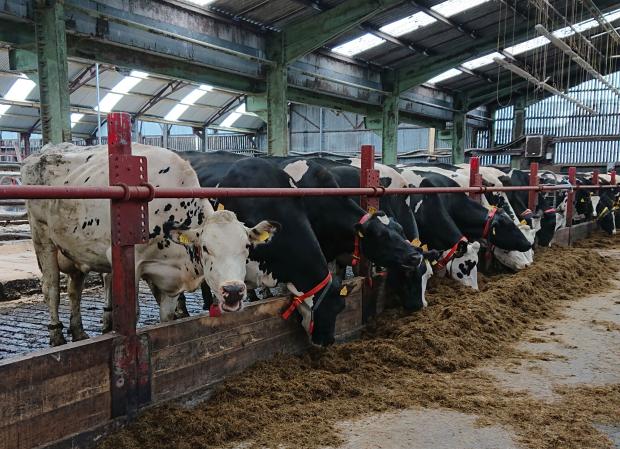
To see if this theoretical consideration actually leads to practical problems when assessing welfare, AFBI staff assessed the same farms repeatedly, at 3-month intervals. Welfare assessment was performed according to the Welfare Quality® protocol. This protocol is the result of years of intense collaboration between many animal welfare researchers throughout Europe. It describes accurate ways to assess different aspects of welfare indicated as essential by a variety of stakeholders (e.g., farmers, citizens, scientists). However, the protocol was originally developed for use during the housing season and the effects of seasonal variation have therefore rarely been studied.
The study
The findings presented here are the results of 56 assessments of 14 commercial herds (a subset of the herds included in the AUTODAIRY project) and cover only a selection of the aspects of welfare measured by the full Welfare Quality® protocol. Nine of the studied herds had pasture access during the grazing season, whereas the other five were housed year-round. Several aspects of welfare were found to differ between the seasons. However, this seasonal pattern often differed between the herds that provided pasture access and those that did not. Therefore, these separate patterns are described in this article in addition to the general pattern.
Seasonal effects that mainly affect herds that are housed year-round
The first aspect measured in the Welfare Quality® protocol is called “absence of hunger”. It is based on the percentage of cows that are ‘too lean’ in the herd. In general, the percentage of cows found to be too lean was low throughout the year. However, specifically for those herds that were housed year-round, more ‘too lean’ cows were found during the summer than during the other seasons (Figure 1). This summer dip was observed for all year-round housed herds on the study, although to the extent of the difference varied.
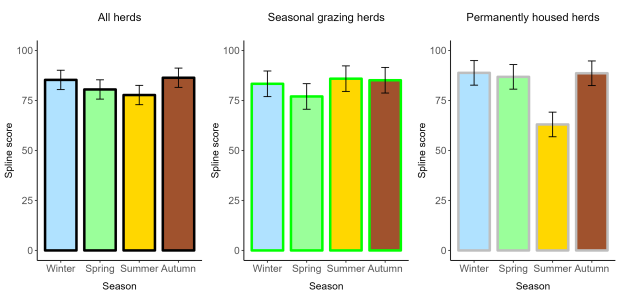
Figure 1. Absence of hunger scores as affected by season. These scores can vary between 0 (all cows too lean) and 100 (no cows to lean). Scores are calculated from the percentage of too lean cows in a non-linear manner. For instance, the summer score for the permanently housed herds (63) corresponds to only 6% too lean cows, whereas their winter score (89) corresponds to only 1.4% too lean cows.
Under “Absence of injuries” the Welfare Quality protocol combines mobility issues with bald spots, lesions and swellings. Specifically those herds that were housed year-round showed a better score during autumn than during winter and spring, and a worse score during summer (Figure 2). Again, all housed herds on the study showed this summer dip, but to a different extent. For the herds with seasonal pasture access the score was more even throughout the seasons.
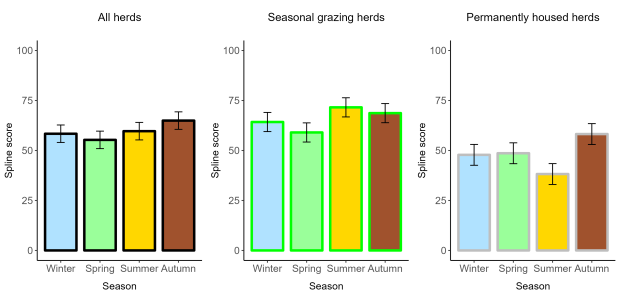
Figure 2. Absence of injury scores as affected by the season. These scores integrate mobility with bald spots, lesions and swellings and can vary between 0 (worst) and 100 (best).
Seasonal effects that mainly affect herds with seasonal pasture access
Under “comfort around resting” the Welfare Quality® protocol measures how easily cows lie down and if they collide with equipment (like cubicle separators) when doing so, if they are lying (partially) outside the cubicles, and how clean their udders, flanks and legs are. Seasonal grazing herds scored better during spring and summer than during autumn and winter. A more even pattern throughout the year was found for the permanently housed herds (Figure 3). Scores for “social behaviour” (how often the cows butt or shove each other) and “positive emotional state” (an interpretation of the cow’s ‘body language’) peaked during the summer for the grazing herds, whereas such a peak was missing for herds housed year-round (Figure 4 and 5). These herds instead reached their highest values in autumn.
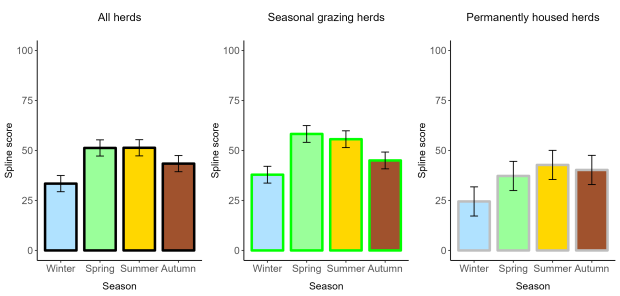
Figure 3. Comfort around resting scores as affected by season. These scores can vary between 0 (worst) and 100 (best) and integrate the assessment of cleanliness and lying behaviour.
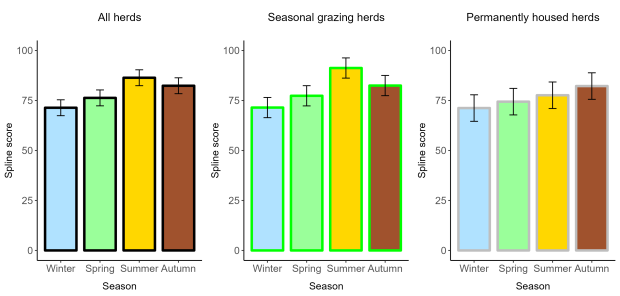
Figure 4. Social behaviour. These scores integrate shoving and butting and can vary from 0 (worst) to 100 (best).

Figure 5. Positive emotional state. The cow’s “body language” is used to infer her emotional state. Scores can vary from 0 (worst) to 100 (best).
Within the protocol, fear of humans is tested by approaching cows where they are feeding, and seeing how closely the cow can be approached before she withdraws. Specifically for the grazing herds this score showed a dip during the summer (Figure 6). However, it is likely that this dip is due to the context that the test is performed in, rather than an actual difference in fearfulness. During the summer, herds with pasture access were tested out on pasture. This means that a withdrawing cow can easily move to a different patch of grass. In contrast, when the test is performed indoors the cow is approached from the feed rail and withdrawing from the approaching human means moving away from the feed. This probably makes cows more likely to move away if tested outdoors, even when they are equally fearful of humans.
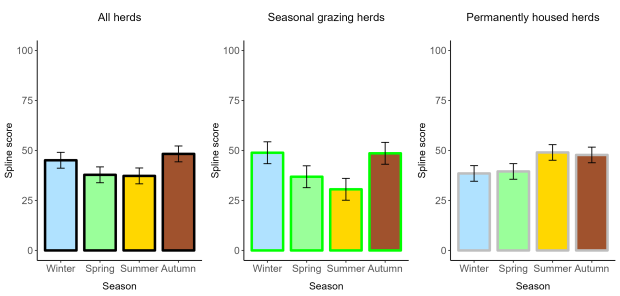
Figure 6. Fearfulness as measured in the approach test. Scores vary from 0 (least fearful) to 100 (most fearful) but are likely biased by the location of the test.
Conclusion
In conclusion, we found that several aspects of animal welfare differed throughout the seasons. Further data collection is currently still ongoing which will allow us to confirm these findings in a greater number of herds, as especially the number of housed herds is limited so far. Nonetheless, clearly diverging seasonal patterns are already emerging. Several aspects of welfare improved during the summer for grazing herds. In contrast, for housed herds summer scores for some aspects of welfare were below scores for other seasons. This means that to assess year-round welfare correctly, assessment should be performed multiple times per year, rather than relying on a single visit during the housing season.
Notes to editors:
AFBI is an arms-length body of DAERA delivering research and development, diagnostic and analytical testing, emergency response capability and expert scientific advice for DAERA and other government departments, public bodies and commercial companies in Northern Ireland, and further afield.
AFBI’s Vision is “Scientific excellence delivering impactful and sustainable outcomes for society, economy and the natural environment”.
AFBI’s Purpose is to deliver trusted, independent research, statutory & surveillance science, and expert advice that addresses local and global challenges, informs government policy and industry decision making, and underpins a sustainable agri-food industry and the natural and marine environments.
AFBI’s strategic priorities:
Leading improvements in the agri-food industry to enhance its sustainability;
Protecting animal, plant and human health;
Enhancing the natural and marine environment;
Delivering quality outcomes and impact;
Enabling world class science through excellence in people, places & technology.